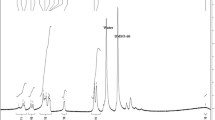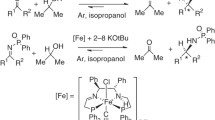Abstract
Polycondensation reactions of phenols with phthalic anhydride were carried out in the presence of ferric hydrogensulphate under melt conditions. The reactions proceeded in short reaction times by using a catalytic amount of Fe(HSO4)3 and the corresponding fluorescein derivatives were obtained in high yields. The simplicity, scale-up, along with the use of an inexpensive, non-toxic, recyclable catalyst of an environmentally benign nature, are other remarkable features of the procedure. The absorption and emission properties of these fluorescein derivatives were studied.
Similar content being viewed by others
References
Cihelník, S., Stibor, I., & Lhoták, P. (2002). Solvent-free synthesis of sulfonephthaleins, sulfonefluoresceins and fluoresceins under microwave irradiation. Collection of Czechoslovak Chemical Communications, 67, 1779–1789. DOI: 10.1135/cccc20021779.
Eshghi, H. (2006). Ferric hydrogensulfate catalysed Schmidt reaction of ketones to amides under solvent-free conditions. Journal of the Chinese Chemical Society, 53, 987–990.
Eshghi, H., Bakavoli, M., & Moradi, H. (2009a). Ferric hydrogensulfate catalyzed aerobic oxidative coupling of 2-naphthols in water or under solvent free conditions. Chinese Chemical Letters, 20, 663–667. DOI: 10.1016/j.cclet.2008.12. 045.
Eshghi, H., Bakavoli, M., & Moradi, H. (2008a). Fe(HSO4)3: An efficient, heterogeneous and reusable catalyst for the synthesis of 14-aryl- or alkyl-14H-dibenzo[a,j]xanthenes. Chinese Chemical Letters, 19, 1423–1426. DOI: 10.1016/j.cclet.2008. 09.048.
Eshghi, H., Bakavoli, M., Moradi, H., & Davoodnia, A. (2009b). Fe(HSO4)3 and Fe(HSO4)3/DMSO as efficient, heterogeneous, and reusable catalyst systems for the oxidative coupling of thiols. Phosphorus, Sulfur and Silicon and the Related Elements, 184, 3110–3118. DOI: 10.1080/10426500802704654.
Eshghi, H., Mirzaie, N., & Asoodeh, A. (2011). Synthesis of fluorescein aromatic esters in the presence of P2O5/SiO2 as catalyst and their hydrolysis studies in the presence of lipase. Dyes and Pigments, 89, 120–126. DOI: 10.1016/j.dyepig.2010. 09.013.
Eshghi, H., Rahimizadeh, M., & Saberi, S. (2008b). Fe(HSO4)3 as an inexpensive, eco-friendly, heterogeneous and reusable catalyst for acetal/ketal formation and their facile regeneration. Catalysis Communications, 9, 2460–2466. DOI: 10.1016/j.catcom.2008.06.015.
Fatima, K., Nosheen, S., Azhar, H., & Azhar, M. (2009). Synthesis and application of eosin. Pakistan Journal of Agricultural Sciences, 46, 1–7.
Gronowska, J., & Dabkowska-Naskret, H. (1981). Fluoran derivatives. Part IX. Synthesis of halofluorans. Polish Journal of Chemistry, 55, 2151–2163.
Heller, E., Klöckner, J., Lautenschläger, W., & Holzgrabe, U. (2010). Online monitoring of microwave-enhanced reactions by UV/Vis spectroscopy. European Journal of Organic Chemistry, 2010, 3569–3573. DOI: 10.1002/ejoc.201000441.
Hilderbrand, S. A., & Weissleder, R. (2007). One-pot synthesis of new symmetric and asymmetric xanthene dyes. Tetrahedron Letters, 48, 4383–4385. DOI: 10.1016/j.tetlet.2007.04. 088.
Kojima, H., Nakatsubo, N., Kikuchi, K., Kawahara, S., Kirino, Y., Nagoshi, H., Hirata, Y., & Nagano, T. (1998). Detection and imaging of nitric oxide with novel fluorescent indicators: diaminofluoresceins. Analytical Chemistry, 70, 244–2453. DOI: 10.1021/ac9801723.
Miura, T., Urano, Y., Tanaka, K., Nagano, T., Ohkubo, K., & Fukuzumi, S. (2003). Rational design principle for modulating fluorescence properties of fluorescein-based probes by photoinduced electron transfer. Journal of the American Chemical Society, 125, 8666–8671. DOI: 10.1021/ja035282s.
Mizukami, S., Kikuchi, K., Higuchi, T., Urano, Y., Mashima, T., Tsuruo, T., & Nagano, T. (1999). Imaging of caspase-3 activation in HeLa cells stimulated with etoposide using a novel fluorescent probe. FEBS Letters, 453, 356–360. DOI: 10.1016/S0014-5793(99)00755-3.
Mugherli, L., Burchak, O. N., Chatelain, F., & Balakirev, M. Y. (2006). Fluorogenic ester substrates to assess proteolytic activity. Bioorganic & Medicinal Chemistry Letters, 16, 4488–4491. DOI: 10.1016/j.bmcl.2006.06.037.
Peng, T., & Yang, D. (2010). HKGreen-3: A rhodol-based fluorescent probe for peroxynitrite. Organic Letters, 12, 4932–4935. DOI: 10.1021/ol102182j.
Rahimizadeh, M., Eshghi, H., Bakhtiarpoor, Z., & Pordel, M. (2009). Ferric hydrogensulfate as a recyclable catalyst for the synthesis of some new bis(indolyl)methane derivatives. Journal of Chemical Research, 2009, 269–270. DOI: 10.3184/030823409X430194.
Sun, W.-C., Gee, K. R., Klaubert, D. H., & Haugland, R. P. (1997). Synthesis of fluorinated fluoresceins. The Journal of Organic Chemistry, 62, 6469–6475. DOI: 10.1021/jo9706178.
Tanaka, K., Miura, T., Umezawa, N., Urano, Y., Kikuchi, K., Higuchi, T., & Nagano, T. (2001). Rational design of fluorescein-based fluorescence probes. Mechanism-based design of a maximum fluorescence probe for singlet oxygen. Journal of the American Chemical Society, 123, 2530–2536. DOI: 10.1021/ja0035708.
Tsien, R. Y., & Waggoner, A. (1995). Fluorophores for confocal microscopy. In J. B. Pawley (Ed.), Handbook of biological confocal microscopy (2nd ed., pp. 267–279). New York, NY, USA: Plenum Press.
Weissleder, R., & Ntziachristos, V. (2003). Shedding light onto live molecular targets. Nature Medicine, 9, 123–128. DOI: 10.1038/nm0103-123.
Windholz, M. (1976). The Merck index (9th ed.). Rahway, NJ, USA: Merck.
Woodroofe, C. C., Lim, M. H., Bu. W., & Lippard, S. J. (2005). Synthesis of isomerically pure carboxylate- and sulfonatesubstituted xanthene fluorophores. Tetrahedron Letters, 61, 3097–3105. DOI: 10.1016/j.tet.2005.01.024.
Zaikova, T. O., Rukavishnikov, A. V., Birrell, G. B., Griffith, O. H., & Keana, J. F. W. (2001). Synthesis of fluorogenic substrates for continuous assay of phosphatidylinositol-specific phospholipase C. Bioconjugate Chemistry, 12, 307–313. DOI: 10.1021/bc0001138.
Author information
Authors and Affiliations
Corresponding author
Rights and permissions
About this article
Cite this article
Eshghi, H., Mirzaie, N. Ferric hydrogensulphate as a recyclable catalyst for the synthesis of fluorescein derivatives. Chem. Pap. 65, 504–509 (2011). https://doi.org/10.2478/s11696-011-0024-3
Received:
Revised:
Accepted:
Published:
Issue Date:
DOI: https://doi.org/10.2478/s11696-011-0024-3




